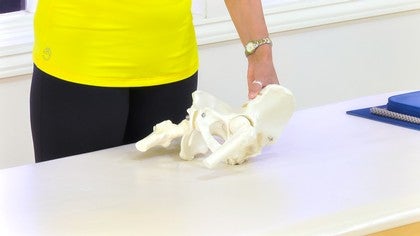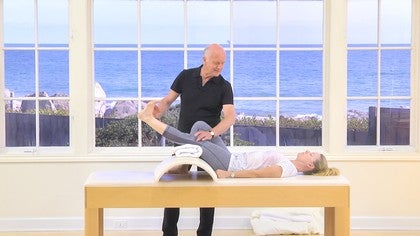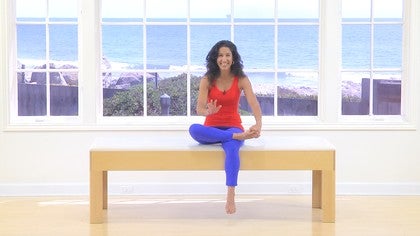Description
About This Video
Transcript
Read Full Transcript
Hi, I'm Shelly power from Pollstar plays in Miami. And today we're going to talk about the hip, the hip joint. And probably one of the most commonly asked questions in the placemat class is why does my hip pop? It makes these strange popping noises when I'm doing some of the exercises. So we're gonna explore the hip joint a little bit, show you what it's made of, the bones that make up the hip joint, and then talk about some ways that you can decrease, maybe get rid of, but at least decrease the popping that you have when we're doing exercises like single leg stretch or leg circles.
So one of the things we like to focus on is the alignment of the bones. And if we look at the pelvis, basically we're talking about two different parts. We have the femur or the five bone, which extends down to the knee and in articulate with the pelvis. And there's a ball and socket joint that has a very round movement. So we sometimes talk about the hip as being a hinge, but really it's not a hinge as in a door opening so much as it is a rolling motion that happens in that socket.
And so we would think that our leg circles and all of our movement would have that same quality if the bones are aligned right and the muscles and do what they need. Sometimes though that's not what happens and we do get this clicking or popping sound and most of the time there's no pain with it. And that's really something that you need to take into consideration when you're doing these things. Does it hurt? And if it hurts, it's probably a good idea to go and have someone check it out. A really good physical therapist or an osteopath who can look at it and make sure that there's not something wrong really wrong if it doesn't hurt and it's just kind of that annoying sound and you can feel it a little bit. Here are some things that might help you. One is, and let's say we're doing the leg circles, so you're lying on your back and the leg is moving around through space and often when the leg opens to the side, you get that pop.
One of the things that we hear a lot or I hear when I'm listening to different classes is we talk a lot about changing the alignment of the leg. So sometimes your teachers will ask you to turn in or turnout and oftentimes that's helpful, gets rid of it or at least decreases the pop. But if it doesn't, you might want to look at how your pelvis is inclined. So sometimes you'll hear teachers talk about a neutral position. Sometimes they'll talk about a tucked position and we like to be more toward a neutral or optimal position. And we can think about that of the bones of the hip here and the pubic bone being almost horizontal and you can make some adjustments for your own body.
If you do that. Sometimes that will take away the popping because what we're going to do is change the relationship between those two bones. And so the muscle that one of the muscles that we're looking at is your so as muscle, and you've probably heard that teachers talk about the Psoas are the one of the hip flexors and it comes down the front part of your spine and it passes in to connect up onto your thigh bone. And when that is, when those two bones aren't out of alignment, sometimes it gets kind of stuck in the tendon of that muscle, sometimes pops over some things and that's often what we're hearing. So what I encourage you to do as you're doing your leg circles is not only change the leg that's moving, but see if you can also change the position of your pelvis a little bit and make really small changes. Tilt a little bit away towards your tailbone, possibly tilt back a little bit toward the mat and find, look for that point where the pelvis starts to be in a relationship to your leg that you don't get any of the popping. Another thing that's really important is to think about length or to embody length in your leg circles.
This is tough when you're doing leg circles that are quick, so when you're going through your leg circles, see if you can slow it down a little bit, especially if you're practicing at home and you can take all the time that you want. See if you can slow it down a little bit and lengthen a little bit more. That combined with moving the pelvis will often take away that pop, makes it more comfortable and might even allow you to have a bigger leg circle, which would be really cool and that would be a good challenge to to work toward. Another different thing that we hear in classes a lot, and this is when people are lying on their sides, is they often talk about this kind of bumpy, bony part out at the top of the thyme and that's often also the place that people think their hips are, which it's not. Your hip joints are actually much, much closer inside, way deep in the pelvis, but that point out there, it's called the greater trow canter, which is kind of a big word, but it's not bony prominence and you can feel it on yourself. That sticks out to the side. For a lot of people it's not a problem.
They can lie on their side for sidekick or any of the sideline exercises, they don't feel a thing, but sometimes people really that's very irritated feeling there and there is a bursa. It's one of those little fluid sacs. It's supposed to cushion. Sometimes it's just not enough. So what you can do if that's bothersome in class is take some different prompts, cushions, pillows, little things that you can put under your thigh and sometimes even you can make a little bit of a donut almost so that the, the point that that sticks out is going to go inside the donut and the rest of it would make some sort of a arrangement like this so that it takes the pressure off of that bone. Now that's not very pretty, but it helps and does the trick. The up thing you can do is instead of patting the part that's already sticking out more than the rest of you is put your pad just underneath that. And sometimes that'll just take the weight away enough that you can lie on your side for a long period of time, not have any discomfort.
So there's lots of different things that you can get this pads a little bit thicker and a little bit heavier. And this is just a piece of a yoga mat that was cut up and you can have that as well. Something just soft to put there, maybe even a towel or something small that you have at your house. So that's gonna help with the hip. Another common thing that happens is hip replacement. And a lot of people have questions about what they should do, what they should avoid during any exercise, especially in a place mat class because there's so much work that we do with the hip joint. And the important thing is to always stay in touch with your doctor, the surgeon or your physical therapist because they're going to have the best advice for you as to what's for your body, really the best plan.
But here are some general things that we know and can incorporate into the classes. So for many, many years, the hip replacement has gone in through the back part of the hip, just behind the hip joint and you'll see sometimes there's a long scar. There are a few, if you have one, you know how long that can be and that's where they go in to perform the procedure. And so the very common for cautions that we see for any movement you want to avoid, especially the combination of bringing your knee to your chest or hip flection, crossing your knee across center, and then adding in the internal rotation as if you were going to bring the top of your thigh towards your abdomen. That combination puts the Femur, your thigh bone in the same position that they use to dislocate it when they did the surgery. I know it's a little bit gross, but that's what we want to avoid. We don't want to put pressure back in the same direction that there's already been some intervention.
So you want to stay away from those positions, especially if they're combined. And that might be something, um, like you were changing positions or even sitting in the mermaid position. For some people that's not maybe the best choice. You might find a different way to sit. Maybe with the legs crossed or even sitting up on a stool or a ball or something. A newer approach is going in through the front, the anterior approach, and that goes in through the front part of the pelvis and it has different precautions than the post area. So we no longer have to worry about bringing your knee to the chest.
Now we have to worry more about taking the leg behind. And I don't mean worrying more, just be conscientious about how and how much you're doing it. So what we'd want to avoid now is taking the leg to the back, so going into hip extension and external rotation. So again, that combination of movement is what again, what they use to do the surgery. And you just want to be careful with those combined movements.
So I hope that this has been empowering. You've learned some different little tips and tricks as to how to make yourself more comfortable in a mat class. We've given some a light on the $64 million question about why does my hip hop and why does my hip hurt when I lie on the side? And I hope these things have been helpful and we'll see you in math class very soon.
Active Aging - Playlist 9: Common Aches and Pains
Comments
You need to be a subscriber to post a comment.
Please Log In or Create an Account to start your free trial.

































